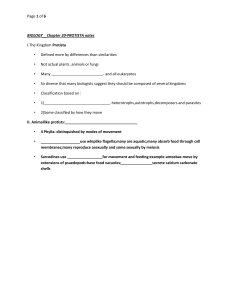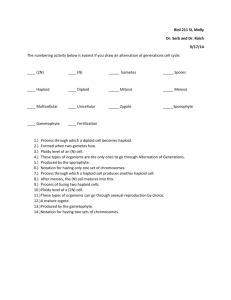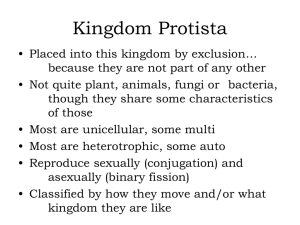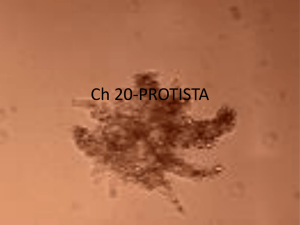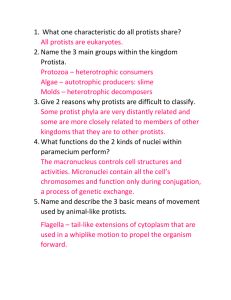Kingdom Protista Powerpoint
advertisement
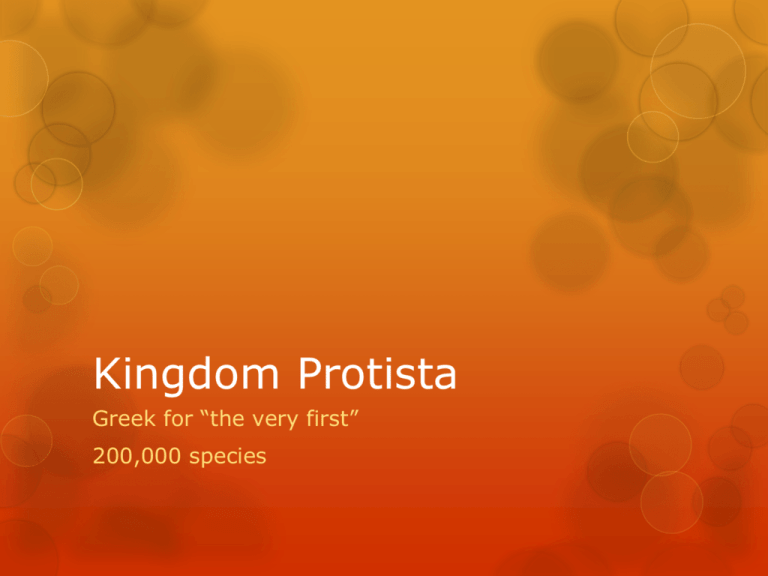
Kingdom Protista Greek for “the very first” 200,000 species 20-1 Kingdom Protista • Any organism that isn’t a plant, animal, fungus, or prokaryote • Has a nucleus & membrane bound organelles • Most are unicellular, some multi-cellular • First eukaryotic organisms on Earth • Can only grow & reproduce in wet environments • Found in Plankton- important food source for others • Feed mainly on bacteria Lynn Margulis- hypothesis that protists came from mitochondria & chloroplasts of prokaryotes that began to live inside larger cells Sub-divided by the way they get nutrition, not based on evolutionary history 20-2 Protozoans-animal-like A. Zooflagellates- swim using flagella Found in lakes & streams or inside other organisms Absorb nutrients from decaying material Sexual & asexual reproduction Ex: Trichonympha- live in gut of termite Trypanosoma- African sleeping sickness, destroys red blood cells, spread by tsetse fly B. Sarcodines- use pseudopodstemporary projections of cytoplasm (oozing blob) Have food vacuole-stores food Unfavorable conditions- they become a cyst Ex: Amoebas- binary fission, big blobs Foraminiferans & Radiolarians hard shells of calcium carbonate, food source for marine environment, when they die>build up chalk on ocean bottom & cliffs Cliffs of Dover- England http://www.youtube.com/watch?v=U7C oBXzJLWM C. Ciliates- use cilia, fresh & salt water Ex: Paramecium- most common, freshwater Parts: Pellicle- outer membrane Trichocysts- defense structures Macronucleus- multiple copies of genes used for everyday Micronucleus- reserve copy of all genes Gullet/oral groove-sweep algae & bacteria to make food vacuole Anal pore- removes waste Contractile vacuole- expels excess water Ciliate reproduction Most are asexual Conjugation- exchange genetic material with others Line up side by side & swap a pair of micronuclei NO new individuals > Not reproduction, just a sexual process to exchange genes & create genetic diversity D. Sporozoans- do not move on their own Parasites Sporozoites- transmitted through fluids Ex: Plasmodium- causes Malaria Carried by Anopheles mosquito, infects liver, bursts red blood cells African Sleeping Sickness http://animal.discovery.com/videos/monsters-inside-meafrican-sleeping-sickness.html Monsters Inside Me: Brain Eating Amoeba http://animal.discovery.com/videos/monsters-inside-methe-brain-eating-amoeba.html 20-3 Plant-like Protists Have chlorophyll > photosynthesis Low amounts of light in sea, so they have adapted and can use more than just red light. Also, use accessory pigments (carotenoids, xanthophylls) Unicellular 1. Euglena- have 2 flagella, no cell wall Great swimmers, freshwater Eyespot- helps find light Can also live as heterotrophs Asexual Pellicle- outer membrane, allows to live in mud 2. Dinoflagellateswrapped around them 2 flagella Asexual ½ photosynthetic, ½ heterotrophs Luminescent- give off light No histones for DNA to wind around http://www.youtube.com/watch?v=eSROHwGaL Cg 3. Chrysophytes- yellow green algae Gold colored chloroplasts Store food in the form of oil Sexual & asexual Form thread like colonies 4. Diatoms- cell walls contain silicon (glass) Extras Phytoplankton- does 70% of all the photosynthesis on Earth Symbiosis- lives in coral reef Algal Blooms- love growing in sewage Clean up waste but deplete water of oxygen, so kill off fish Ex: red tides http://www.youtube.com/watch?v=VKx-B0zLXu8 20-4 Multicellular Plant-like protists 5. Red Algae- Rhodophyta- red plants Can live at great depths- great photosynthesizers Found from polar to tropical waters Lack flagella Stabalize coral reefs- coralline algae has calcium carbonate in cell walls 6. Brown Algae- Phaeophyta Chlorophyll a & c Largest and most complex Giant Kelp- over 60 m long Contain a holdfast- anchors to bottom or rocks http://www.youtube.com/watch?v=ZQb9ZFWfNZE 7. Green Algae- Chlorophyta act as plants thought to be closely related to moss Ex: sea lettuce Bio I- Review terms Diploid vs Haploid Mitosis vs Meiosis Body cells vs sex cells Reproduction of Algae Alternation of Generations- switch between diploid & haploid stages Chlamydomonas- mostly asexual- makes zoospores by mitosis But during unfavorable conditions- sexual, releases + & gametes (haploid) that pair together to make a zygote (diploid) Grows thick protective wall and when conditions are right, becomes haploid again Ulva- Sea Lettuce Diploid & haploid cycles are almost same Human uses for Algae Food sources for oceans Earth’s oxygen from photosynthesis Sushi wraps, used to make ice cream, salad dressings, pudding, plastics, paints 20-5 Fungus-like Protists Grow in damp areas Absorb food through membranes Have centrioles (fungi don’t) Lack chitin cell walls Slime Molds Forest floors Cellular-cell membranes Acrasiomycota Most of life is free-living When conditions are bad > secretes chemical to form large colony with nearby cells Colony migrates, makes fruiting body that produces spores Acellular Myxomycota Known as plasmodia Many nuclei Mature sporangium > haploid spores Water Molds- Oomycota Feed on dead or decaying matter in water or on plants on land Hyphae- cell walls of cellulose & motile spores Fungi don’t have Asexual- Zoosporangia (spore cases) Sexual- Antheridium- male nuclei, Oogonium- female nuclei Facts Important recyclers of organic material Can be harmful- mildew, blights of grapes & tomatoes 1840’s- potato #1 food in Ireland 1845- Phytophora infestans = Great Potato Famine 1.5 million migrate to US Potato Famine Potato Famine http://www.bing.com/videos/search?q=great+potato+fa mine&FORM=HDRSC3#view=detail&mid=C7916254073 6123451AEC79162540736123451AE Protists Protists http://www.youtube.com/watch?v=-zsdYOgTbOk Plant-like http://www.youtube.com/watch?v=o5ESHXKGBvA Summation video https://www.youtube.com/watch?v=Ln69k7LyTsU

